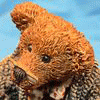
After much banging my head on the peverable wall I have the preliminary linework done for the folding wing two seat Nuthatcher. The seating is side by side with a center stick to make it easier to get in and out of this thing. By happenstance there is room in the cabin for someone to sleep in a reclining position if you are chummy two people could get a bit of sleep.
The heavy lines are the outline and the lighter lines are structural members. The flat bulkhead above and forward of the cabin is the firewall and the engine will sit forward and above this.
The heavy lines are the outline and the lighter lines are structural members. The flat bulkhead above and forward of the cabin is the firewall and the engine will sit forward and above this.
Category Photography / Miscellaneous
Species Unspecified / Any
Size 1280 x 960px
File Size 116.2 kB
Listed in Folders
I wish I did too... or maybe it's better I don't. The way it is now I think outside of the box with a lot of the stuff I have designed and built. As an aeronautical engineer they are trained to think a certain way so they have a hard time thinking out side of their box or cubical of knowledge.
Myself I have knowledge in many different fields so I have a larger pool of knowledge to draw from.
Myself I have knowledge in many different fields so I have a larger pool of knowledge to draw from.
I understand my friend, I too have flown RC, but the narrower wing cord has less induced drag for a given wing area. The narrower cord wing has better rate of climb and service ceiling than a lower aspect ratio wing of the same area and power. The narrower cord wings works better on low horsepower aircraft.
I have used a spreadsheet to numerically model the design to get projected performance numbers. I also used them to work out tail volumes and stress loads. When we build it we well static load test to prove the numbers. The nice thing about the design is it has a gross weight of 1300 pounds but we may designe it for 1500 pounds in case someone moves it out of the light sport class of aircraft.
So, this isn't exactly aerospace engineering software, but it also isn't tens of thousands of dollars. Might be worth checking out to refine your work before building.
https://store.steampowered.com/app/...../SimplePlanes/
https://store.steampowered.com/app/...../SimplePlanes/
No it's not aerospace engineering... it is a few steps up from pencil, paper and a sliderule... by the way that's how pre computer era aircraft were designed... I haven't used a sliderule in so long I have forgotten how to use one...
All my design work will be checked by a good friend who is a mechanical engineer, that is an aviation enthusiast and pilot. I know I'm doing something right because he is thinking strongly about building my design over his own work. Yes his hobby is designing low powered aircraft. He likes what he sees in the Nuthatcher and the utility of the design. That flat slope behind the cabin has a reason... where do you put the folding camp chairs in a light aircraft? Or other light and bulky things? You lash then to the slope on the outside of the aircraft in that space.
All my design work will be checked by a good friend who is a mechanical engineer, that is an aviation enthusiast and pilot. I know I'm doing something right because he is thinking strongly about building my design over his own work. Yes his hobby is designing low powered aircraft. He likes what he sees in the Nuthatcher and the utility of the design. That flat slope behind the cabin has a reason... where do you put the folding camp chairs in a light aircraft? Or other light and bulky things? You lash then to the slope on the outside of the aircraft in that space.
I understood your reasoning but I'm sure the game is not going to have the airfoil I'm using and is programmed for a generic airfoil so it wouldn't handle the same. I'm also not a gamer. The game is not going to have the feel or likely to react the same as the real bird in the real world.
Dang interesting. The guy (Karl - aka Charlie and Whiskey Charlie) I mentioned, well he was Austrian and his flight training was at age 15 - gliders and trainers then in the cockpit of a ME 109 in 1944 thru 1945 on the Eastern Front. Must have been a damn good pilot to survive that. By the Mid 1950s he was flying again after moving to Canada. One of his sportsman clients was some big shot with Eastern Airlines. He asked Karl about his flgiht hours - he pulled out his flight books going back to 1944. Ended up flying for Eastern first in Canada then in the US. Went from shooting at Boeing Products to flying them. Eventually captained 747s on the Hawaii route

 FA+
FA+

















Comments